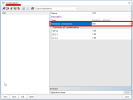Sequential analysis
Definition, application
Two types of calculation can be combined in one analysis, where the results of a first calculation are used as initial state for the second calculation. It is for use cases where it is necessary to calculate for example stability or modal analysis after nonlinear analysis of structure.
Some use cases:
- Combine results of a nonlinear combination with some linear load cases, e.g. mobile loads or seismic
- Use the deformed state of a structure after a nonlinear analysis as initial state for a stability analysis
- Use the stress state of a structure after a nonlinear analysis as initial stress state for a dynamic analysis
Sequential analysis is supported only in Post-processing environment 'v16 and older' (32 bit version only).
Where to find it
Enable sequential analysis
In Project settings
- in the Basic data tab, select Post-processing environment 'v16 and older'
- in the Functionality tab, under Detailed and Nonlinearity, tick the option Sequential analysis.
Specific data input
Define calculation sequences by assigning a nonlinear combination to a linear Combination, a Stability combination or a Combination of mass groups.
Possibilities
Running the calculation
In general, run the final target calculation. SCIA Engineer will determine the dependencies due to sequential analysis settings and run all necessary pre-requisite calculations before running the final calculation.
Example:
- in case a stability combination uses a nonlinear combination as initial deformed state
- run the stability analysis
- SCIA Engineer will first run the pre-requisite nonlinear calculation and then the requested stability analysis
Results
There is no particular steps that are required for results output from a sequential analysis.
There are however a few restrictions for specific types of sequential analysis.
For sequential analysis NC in Combinations, only the following types of results are supported
- Beams
- 2D Members
- Displacement of nodes
- Member 2D - Internal forces
- Member 2D - Stresses
(e.g. support reactions and storey results are not supported for that type of analysis)




